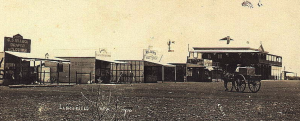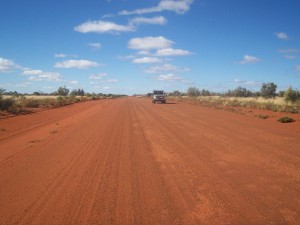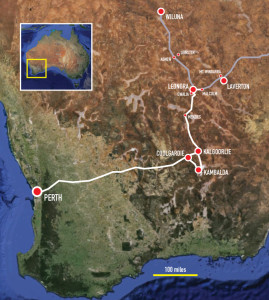I experienced my first earthquake when I was about two years old. Of course I have no recollection of it myself, but I heard all about it later. It was October 14, 1968, in Meckering, a small town about 130 km east of Perth. The 40-second quake measured 6.9 on the Richter Scale and basically destroyed the town. We were there then, in a caravan in town. Dad was off working somewhere. I was with my mother in the van; she recalls that the van started rocking back and forth, and at first she thought it was a few goons playing some kind of joke. She got irritated, ran outside to confront the goons, but was instead shocked to find the ground moving about in waves, buildings swaying back and forth. Photographs of the aftermath show considerable damage, including railway lines offset several feet and vertical faulting as much as 9 feet. I was apparently unaffected by the whole thing. I’d have to wait another 20-odd years before I’d feel another earthquake — in California — and remember the experience.
Railway tracks after the Meckering quake. (1)
As mentioned earlier, Dad followed construction work wherever it could be found, and there was plenty of it in the wake of mineral exploration in the state. In addition to iron in the Kimberly’s, there was nickel to the south around Kalgoorlie, a town built on gold discovered there in the late 1800s. Nickel mining brought a much-needed infusion of life to the economy of the area. Gold was the original source of prosperity for the Eastern Goldfields. There are a few significant finds that weathered drops in the availability or the price of gold, notably Kalgoorlie and Coolgardie. Alluvial gold petered out quickly and men went underground for more. Literally thousands of gold mines didn’t survive their initial jackpot, and the various small towns that popped up around them faded into obscurity, dissolved back into the desert. Nickel discoveries around Kambalda, Leinster and Mt. Windarra (near Laverton) brought hope of prosperity back. We were in Kambalda for a time, then eventually found ourselves north to Laverton.
Lancefield, a few miles out of Laverton, taken 1910. One of many mining towns emerging during the Gold Rush of the 1890s. The town no longer exists. You might be lucky to find a brick or an old glass bottle nowadays, but nothing else. (2)
Laverton started out as a gold mining town, and old closed mines could be seen as you drove the road from Leonora into Laverton. After the gold and before nickel, Laverton barely survived beyond being the Shire seat. The area supported a pastoral industry, mostly sheep. Getting to Laverton meant driving the sealed road north of Kalgoorlie 150 miles to Leonora, then turning east for another 90 or so miles. The sealed road at the time, around 1971, stopped just outside Leonora, so the rest of the way was gravel. Beyond Laverton is very little but desert. The Outback Highway begins here, a route made up of several highways which are a essentially dirt tracks and gravel roads, extending out across the middle of the continent to Winton, Queensland. The first leg beyond Laverton is the Great Central Road, the main thoroughfare from Perth to Uluru (Ayer’s Rock), about 700 miles. In that distance there are only a handful of fueling stops, and permits are required (for traveling through Aboriginal lands).
Great Central Road near Tjukayirla Roadhouse, about 4.5 hrs drive east of Laverton. The road is passable by most vehicles. Traveling in the Outback involves long distances requiring patience, plenty of water, fuel and supplies, and occasionally permits to access Aboriginal lands. (3)
The way I understood it, Dad was going only as far as the sealed road would take us, and since there wasn’t anything in Leonora at the moment, headed east, and stubbornly continued on to Laverton. Since there wasn’t anything beyond Laverton that involved work, this was as far as we’d go.
My uninterrupted memory timeline began about the time we arrived in Laverton. I was about 5 by then. We still had the little caravan, with bunk beds up the front and the double bed in the back, separated by a tiny kitchen. I mostly slept on the bottom bunk, although I preferred the top bunk, but I wasn’t allowed to sleep up there after I rolled off to the floor below a couple of times. The caravan was parked inside a huge shed that had once been a maintenance facility for nearby gold mines. The outside walls were mostly open, with just the roof providing some protection. Inside the shed were remnants of the old mining days, steam-driven cast-iron pieces of equipment the size of cars. There was also a maintenance pit in the ground, which Dad often used to get under the car to fix it, and which I was reminded many times to stay clear of.
Across the street from the shed was the Laverton Hotel which still stands today, first built around the early 1900s. We became friends of the proprietors. While Dad was off working somewhere, Mum spent time chatting with the lady of the hotel. In the rear was the kitchen, where we spent most of our time. I wanted to explore the hotel but wasn’t allowed beyond the kitchen and the adjoining dining area.
Laverton Hotel, since renamed the Desert Inn Hotel. (4)
It should be noted, and perhaps it’s already obvious, that I was a bit of a terror as a kid. I was always in trouble for something. I was precocious, always fiddling with something I wasn’t supposed to be, and constantly in Dad’s line of fire. With my non-stop tantrums and Dad’s red hot temper, home life was a tinder box, ready to erupt at any given moment. I would seek solace from Mum, but she had a bit of a temper as well, and it wasn’t always a guarantee that I’d find an ally.
I had an early penchant for running away, sometimes after one of these outbursts. The furthest I ever made it away from the caravan was the kitchen of the hotel. There was one night I’d made it that far, and the hotel lady took me in and made me something to eat, something that included raw onions which I didn’t care for. I wanted to sit in the dining room so I wouldn’t be seen from the side window, but the dining room was closed and I had to sit in the kitchen. It was only a matter of time before I saw Mum walking by the window and I was blown. I was glad it wasn’t Dad, but I knew I was still in a heap of trouble. I didn’t get to eat anything before being dragged back to the van.
Beyond the hotel was the Laverton Primary School, grades 1 through 7, population less than 50. There were two main buildings, an older one in front and a newer one behind, next to the playground. The older building catered to the younger grades, 1 through 4, and the newer one had the older kids and the staff room. I think I was still too young to be in 1st grade, so I must have been in some kind of kindergarten class. All of the kids were together in one room; each grade sat in a clump of desks mashed together, so there were four or five islands of desks in the main room. I made work hard for the one teacher managing all four grades (a dozen or so kids in all), never sitting still, always trying to see what the older kids were doing. It looked more interesting than what I was doing, anyway. If my temper flared and got too out of hand, I’d be put into the storeroom off the main room and left to chill for a while. The storeroom was technically another room with a window looking out, so it wasn’t a closet. It was dusty and drab. I was never happy being in there, screaming my lungs out and getting increasingly agitated when kids would come by the window to stare in at me. The more I screamed, the more entertained they seemed to be, and the more they showed up to gawk at me the more I screamed. There were a number of times when Mum or Dad would have to come and get me out of school, mostly Mum. I feared the days Dad would show up, because it meant I was in for it at home. He had no patience for being called away from whatever he was doing, especially to cater to some screaming kid.
I recall vividly one occasion out on the playground, which was a gravel area with a basketball hoop on one end. I was dared by some kids to take a leak against the basketball pole. That was easy, I simply whipped it out and peed happily away, for all to see and cheer. Within seconds I was snatched up by a teacher and sent off to the storeroom to wait until collected. I screamed myself to sleep.
We weren’t in Laverton for very long. I’m not sure why, because a lot of the new construction (including a new school) was yet to happen. Either way, we ended up on the road again, this time back to Leonora. We got there around 1971, and would be there for the next eight years.
When I did some research on family history a couple of years ago (2013), I was surprised to find that there were family members that had lived in Laverton before, way back around 1902, when the town was fresh and new. I’m preparing all this info for a separate post, because it deserves its own, and it’s fascinating.
It might be worth noting (if not already clear) that growing up in the bush with a temperamental father and distant mother, and a temper of my own, wasn’t all fun and games. However I don’t always think back to these days with dread, wishing perhaps that I could forget all this. I had an experience growing up that was quite unique. Not every kid gets to grow up in a ghost town. Maybe for some that doesn’t have a particular appeal, especially the isolation, heat, flies and angry home life. Angry home life aside, I wouldn’t change anything about those days out in the bush. I reminisce more about my time growing up in Leonora (and specifically Gwalia, which I will introduce shortly) than with any other place. Our time in Leonora/Gwalia was relatively short, just the span of time that I was in Primary School, but I believe it defines me more than anywhere else. It’s now 2015, and I was last there in 1979; it’s been 35+ years since we left the town. I’ve not been back because I didn’t want to, it simply wasn’t possible for various reasons. I’d go back in a heartbeat, at least to visit, certainly to look about at what I grew up around, and more than anything to show my family now (wife and kids) what it was like.
Next, I will introduce you to Gwalia, and begin a recounting of life in a ghost town.
Southwestern Western Australia (click to enlarge) (5)
Photo credits:
1. http://www.ga.gov.au/scientific-topics/hazards/earthquake/basics/gallery
2. http://www.maps.bonzle.com/c/a?a=m&m=sp&p=287&sc=p&most=p#&ui-state=dialog
3. Public domain, via Wiki Commons.
4. http://www.panoramio.com/user/631231?with_photo_id=9056082
5. Google maps, edited by me in Illustrator




